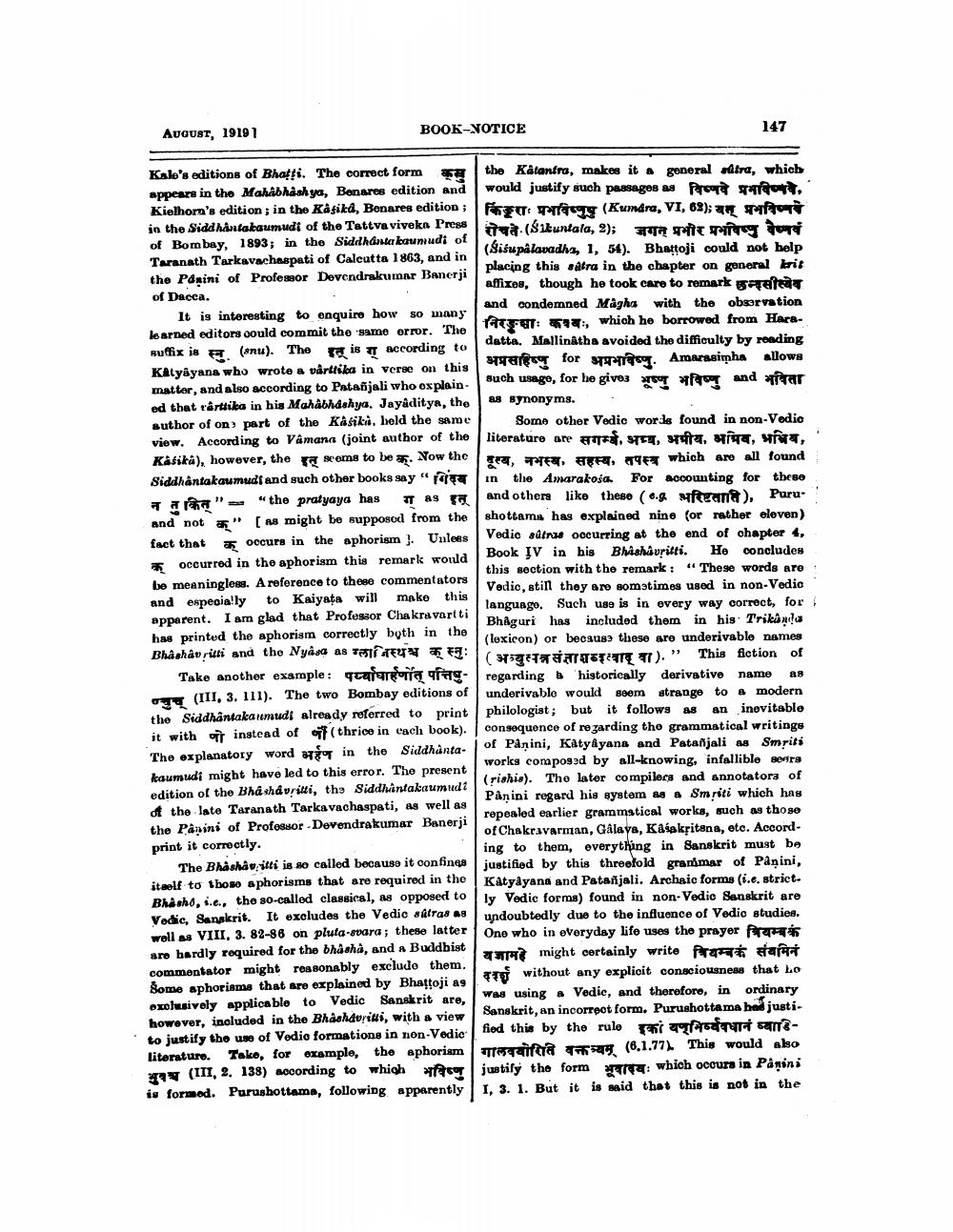________________
AUGUST, 19191
BOOK-NOTICE
Kale's editions of Bhatti. The correct form E appears in the Mahabhashya, Benares edition and Kielhorn's edition; in the Kâşikâ, Benares edition; in the Siddhantakaumudi of the Tattva viveka Press of Bombay, 1893; in the Siddhantakaumudi of
Taranath Tarkavachaspati of Calcutta 1863, and in the Panini of Professor Devendrakumar Banerji
of Dacca.
It is interesting to enquire how so many learned editors could commit the same error. The suffix is (anu). The is according to Katyayana who wrote a vårttika in verse on this matter, and also according to Patanjali who explained that rarttika in his Mahâbháshya, Jayâditya, the author of on part of the Kasika, held the same view. According to Vâmana (joint author of the Käsika), however, the seems to be क्. Now the Siddhantakaumudi and such other books say " गिदय ग 85 इत् "the pratyaya has न तु कित् " and not "[as might be supposed from the occurs in the aphorism]. Unless occurred in the aphorism this remark would be meaningless. A reference to these commentators and especially to Kaiyata will make this apparent. I am glad that Professor Chakravartti has printed the aphorism correctly both in the Bhashavritti and the Nyasa as ग्लाजिस्थश्च क्स्नुः
fact that
Take another example: quafifa fa(III, 3. 111). The two Bombay editions of the Siddhantakaumudi already referred to print it with off instead of off (thrice in each book). The explanatory word ar in the Siddhantakaumudi might have led to this error. The present edition of the Bhashavṛitti, the Siddhantakaumudi of the late Taranath Tarkavachaspati, as well as the Panini of Professor Devendrakumar Banerji print it correctly.
The Bhashav illi is so called because it confines itself to those aphorisms that are required in the Bhisho, i.e., the so-called classical, as opposed to Vodic, Sanskrit. It excludes the Vedic sutras as well as VIII, 3. 82-86 on pluta-svara; these latter are hardly required for the bhasha, and a Buddhist commentator might reasonably exclude them. Some aphorisms that are explained by Bhattoji as exclusively applicable to Vedic Sanskrit are, however, included in the Bhashauriti, with a view to justify the use of Vedic formations in non-Vedic literature. Take, for example, the aphorism (III, 2. 138) according to which is formed. Purushottama, following apparently
147
the Katantra, makes it a general sútra, which would justify such passages as Pro A Flicy (Kumára, VI, 62); ay mag रोचते. (Sakuntala, 2); जगत् प्रभोर प्रभविष्णु वैष्णवं (Sisupâlavadha, 1, 54). Bhattoji could not help placing this satra in the chapter on general krit affixes, though he took care to remark grefer and condemned Magha with the observation
:, which he borrowed from Haradatta. Mallinatha avoided the difficulty by reading अमसहिष्णु for अप्रभविष्णु. Amarasimha allow |such usage, for he gives भूष्णु भविष्णु and भविता
as synonyms.
Some other Vedic words found in non-Vedic literature are सगर्ग्य, अध्य, अमीय, अभिव, अभिय वूल्य, नभस्य, सहस्य, तपस्त्र which are all found in the Amarakosa. For accounting for these and others like these (e.g. ftant), Purushottama has explained nine (or rather eleven) Vedic sûtras occurring at the end of chapter 4, Book IV in his Bhishâvritti. He concludes this section with the remark: "These words are Vedic, still they are sometimes used in non-Vedic language. Such use is in every way correct, for Bhaguri has included them in his Trikanda (lexicon) or because these are underivable names
(अभ्युत्पन्नसंज्ञाशकत्वात् वा ). This fiction of
name as
regarding & historically derivative underivable would seem strange to a modern an inevitable philologist; but it follows as consequence of regarding the grammatical writings of Panini, Katyayana and Patanjali as Smriti works composed by all-knowing, infallible sears (rishis). The later compilers and annotators of Panini regard his system as a Smriti which has repealed earlier grammatical works, such as those of Chakravarman, Gâlaya, Kasakritsna, etc. According to them, everything in Sanskrit must be justified by this threefold grammar of Panini, Katyayana and Patañjali. Archaic forms (i.e. strictly Vedic forms) found in non-Vedic Sanskrit are undoubtedly due to the influence of Vedic studies. One who in everyday life uses the prayer fr यजामहे might certainly write त्रियम्बकं संयमिनं
without any explicit consciousness that Lo was using a Vedic, and therefore, in ordinary Sanskrit, an incorrect form. Purushottama had justified this by the rule इकां यभिर्व्यवधानं व्याडTeciftâ my (6.1.77). This would also justify the form which occurs in Panini I, 3. 1. But it is said that this is not in the




